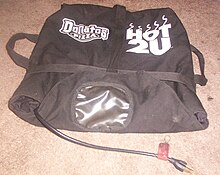
Corrugated fiberboard, corrugated cardboard, or corrugated is a type of packaging material consisting of a fluted corrugated sheet and one or two flat linerboards. It is made on "flute lamination machines" or "corrugators" and is used for making corrugated boxes. The corrugated medium sheet and the linerboard(s) are made of kraft containerboard, a paperboard material usually over 0.25 millimetres (0.01 in) thick.

Take-out or takeout is a prepared meal or other food items, purchased at a restaurant or fast food outlet with the intent to eat elsewhere. A concept found in many ancient cultures, take-out food is common worldwide, with a number of different cuisines and dishes on offer.

Papa John's International, Inc., d/b/a Papa Johns, is an American pizza restaurant chain. It is the fourth largest pizza delivery restaurant chain in the United States, with headquarters in the Louisville, Kentucky and Atlanta, Georgia metropolitan areas.
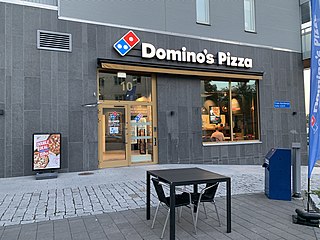
Domino's Pizza, Inc., commonly referred to as Domino's, is an American multinational pizza restaurant chain founded in 1960. and led by CEO Russell Weiner. The corporation is Delaware-domiciled and headquartered at the Domino's Farms Office Park in Ann Arbor Township, near Ann Arbor, Michigan. As of 2018, Domino's had approximately 15,000 stores, with 5,649 in the United States, 1,500 in India, and 1,249 in the United Kingdom. Domino's has stores in over 83 countries and 5,701 cities worldwide.

LaRosa's Pizzeria is a chain of pizzerias serving neighborhoods throughout Ohio, Kentucky, and Indiana. It was founded in 1954 by Donald "Buddy" LaRosa, along with partners Richard "Muzzie" Minella, Mike Soldano and Frank "Head" Serraino. Originally called Papa Gino's, LaRosa later bought out his partners, and changed the name to LaRosa's.

Cardboard boxes are industrially prefabricated boxes, primarily used for packaging goods and materials. Specialists in industry seldom use the term cardboard because it does not denote a specific material. The term cardboard may refer to a variety of heavy paper-like materials, including card stock, corrugated fiberboard, and paperboard. Cardboard boxes can be readily recycled.
Eagle Boys was an Australian fast food pizza chain.
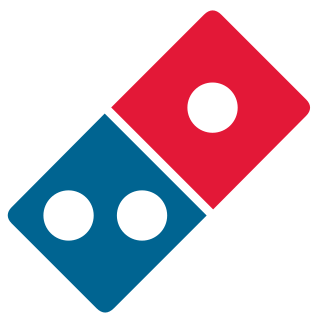
Domino's Pizza Enterprises Limited (DPE) is the largest pizza chain in Australia in terms of network stores numbers and network sales, as well as the largest franchisee for the US Domino's brand in the world. DPE is the exclusive master franchise for the Domino's brand network in Australia, New Zealand, Belgium, France, The Netherlands, Japan, Germany, Luxembourg, Denmark and Taiwan. Across these markets, DPE has over 2,800 stores. In May 2005 DPE became the first publicly listed pizza company in Australia.

Pizza Corner was an international franchise of pizzeria chains that offered a wide range of pizzas, pastas and side dishes from chicken wings to salads. Pizza Corner operated as both standalone restaurants or combined with other Global Franchise Architects brands such as Coffee World or Cream & Fudge. Its service formats included: large dine-in restaurants, delivery outlets, express dine-ins, and express kiosks.

Online food ordering is the process of ordering food, for delivery or pickup, from a website or other application. The product can be either ready-to-eat food or food that has not been specially prepared for direct consumption.

A pizza saver, sometimes referred to as pizza table or pizza stool, is an object used to prevent the top of a food container, such as a pizza box or cake box, from collapsing in at the center and touching the food inside.

Domino's Pizza Group plc is a United Kingdom-based master franchise of international fast food pizza delivery chain Domino's. The company is listed on the London Stock Exchange and is a constituent of the FTSE 250 Index.
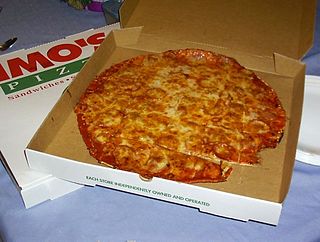
The pizza box or pizza package is a folding packaging box usually made of corrugated fiberboard in which hot pizzas are stored for take-out. The pizza box also makes home delivery and takeaway substantially easier. The pizza box has to be highly resistant, cheap, stackable, thermally insulated to regulate humidity and suitable for food transportation. In addition, it provides space for advertising. The pizza packages differ from those of frozen pizzas, which contain the frozen product in heat-sealed plastic foils as is the case with much frozen food.
The presence of pizza restaurant chains has contributed to a significant increase in pizza consumption in Mainland China and Hong Kong. This also had an effect of introducing cheese as a culinary ingredient and everyday food in China, which was relatively uncommon in Chinese cuisine prior to the emergence of pizza chains. Pizza Hut opened its first store in China in 1990, and several pizza restaurant chains exist in China today.

Slice is an online food ordering platform for independent pizzerias. It allows pizzeria owners to offer their products to their customers using a mobile-optimized website and their customers can place orders through the Slice app and social media channels. The company claims their platform is used by 9,000 pizzerias in 2,500 towns and cities in the US. It also claims to have processed more than $100 million worth of deliveries in 2017 and to have filled a total of over 12 million orders since 2010.

Lonesome's Pizza was a pizzeria in Portland, Oregon. Co-owners Noah Antieu, Nic Reddy, and Nik Sin started the delivery-only business in 2010. In 2012, Lonesome's began operating from a window at the nightclub and music venue Dante's. Known for its quirky pizza names and for including artwork and music with deliveries, the pizzeria closed in 2017.
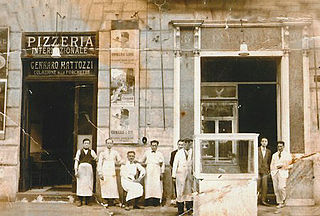
A pizzeria is a restaurant focusing on pizza. As well as pizza, dishes at pizzerias can include kebab, salads and pasta.
The "Pizza Meter" is a term used to describe how the increase in pizza orders from offices of the United States government, such as the White House and The Pentagon, can be indicative of important political or military events. The concept is based on empirical observations and has been mentioned in various media as a possible crisis predictor.


